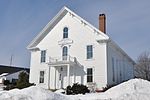Browns River (New Hampshire)
New Hampshire river stubsRivers of New HampshireRivers of Rockingham County, New Hampshire
The Browns River is a 2.9-mile-long (4.7 km) river, primarily tidal, in southeastern New Hampshire in the United States. It is part of the largest salt marsh in New Hampshire, covering over 3,800 acres (15 km2).The river rises in the town of Seabrook just east of U.S. Route 1 and quickly enters the salt marsh and tidewater. For most of its length, the river forms the boundary between Seabrook and Hampton Falls. The river runs along the north side of Seabrook Station Nuclear Power Plant, then ends in Hampton Harbor, where it joins the Hampton River.
Excerpt from the Wikipedia article Browns River (New Hampshire) (License: CC BY-SA 3.0, Authors).Browns River (New Hampshire)
Farm Lane,
Geographical coordinates (GPS) Address Nearby Places Show on map
Geographical coordinates (GPS)
| Latitude | Longitude |
|---|---|
| N 42.895555555556 ° | E -70.835277777778 ° |
Address
Saltmarsh Wildlife Management Area
Farm Lane
03874
New Hampshire, United States
Open on Google Maps







